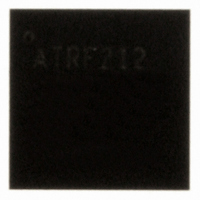AT86RF212-ZU Atmel, AT86RF212-ZU Datasheet - Page 12

AT86RF212-ZU
Manufacturer Part Number
AT86RF212-ZU
Description
IC TXRX ZIGBE/802.15.4/ISM 32QFN
Manufacturer
Atmel
Datasheet
1.AT86RF212-ZU.pdf
(172 pages)
Specifications of AT86RF212-ZU
Frequency
700MHz, 800MHz, 900MHz
Data Rate - Maximum
250kbps
Modulation Or Protocol
802.15.4 Zigbee, 6LoWPAN, ISM
Applications
ISM, ZigBee™
Power - Output
10dBm
Sensitivity
-110dBm
Voltage - Supply
1.8 V ~ 3.6 V
Current - Receiving
9.2mA
Current - Transmitting
25mA
Data Interface
PCB, Surface Mount
Antenna Connector
PCB, Surface Mount
Operating Temperature
-40°C ~ 85°C
Package / Case
32-VQFN Exposed Pad, 32-HVQFN, 32-SQFN, 32-DHVQFN
Number Of Receivers
1
Number Of Transmitters
1
Wireless Frequency
769 MHz to 935 MHz
Interface Type
SPI
Noise Figure
7 dB
Output Power
21 dB
Operating Supply Voltage
1.8 V, 3 V
Maximum Operating Temperature
+ 85 C
Mounting Style
SMD/SMT
Maximum Supply Current
25 mA
Minimum Operating Temperature
- 40 C
Modulation
OQPSK
Protocol Supported
802.15.4
Operating Temperature (min)
-40C
Operating Temperature (max)
85C
Operating Temperature Classification
Industrial
Lead Free Status / RoHS Status
Lead free / RoHS Compliant
Memory Size
-
Lead Free Status / Rohs Status
Lead free / RoHS Compliant
Available stocks
Company
Part Number
Manufacturer
Quantity
Price
Company:
Part Number:
AT86RF212-ZU
Manufacturer:
HITTITE
Quantity:
5 000
Part Number:
AT86RF212-ZU
Manufacturer:
ATMEL/爱特梅尔
Quantity:
20 000
Part Number:
AT86RF212-ZUR
Manufacturer:
MICROCHIP/微芯
Quantity:
20 000
3.2 Extended Feature Set Application Schematic
Figure 3-2. Extended Feature Set Application Schematic
12
AT86RF212
For using the extended features
• Antenna Diversity
• RX/TX Indicator
• RX Frame Time Stamping
an extended application schematic is required. All other extended features (see section
9) do not need an extended schematic.
An application schematic illustrating the use of the AT86RF212 Extended Feature Set is
shown in Figure 3-2. Although this example shows all additional hardware features
combined, it is possible to use all features separately or in various combinations.
In this example, a balun (B1) transforms the differential radio transceiver RF pins
(RFP/RFN) to a single ended RF signal, similar to the Basic Application Schematic;
refer to Figure 3-1. The RF switches (SW1, SW2) separate between receive and
transmit path in an external RF front-end. These switches are controlled by the RX/TX
Indicator, represented by the differential pin pair DIG3/DIG4; refer to section 9.4.
During receive, the corresponding microcontroller may search for the most reliable RF
signal path using an Antenna Diversity algorithm or stored statistic data of link signal
quality. One antenna is selected by a RF switch (SW2) controlled by pin DIG1
RF signal is amplified by an optional low-noise amplifier (N2) and fed to the radio
transceiver using a RX/TX switch (SW1).
uses pins DIG1/DIG2
uses pins DIG3/DIG4
uses pin DIG2
(1)
8168C-MCU Wireless-02/10
section 9.3
section 9.4
section 9.5
(1)
. The













